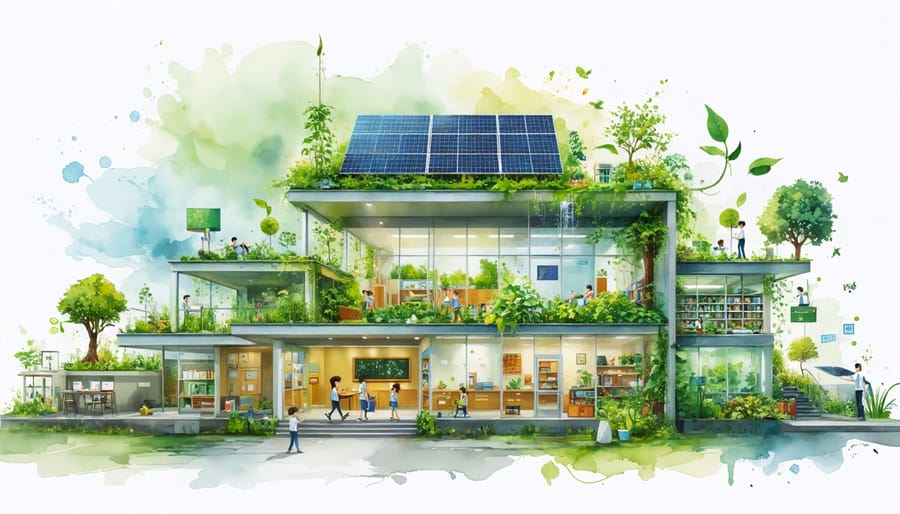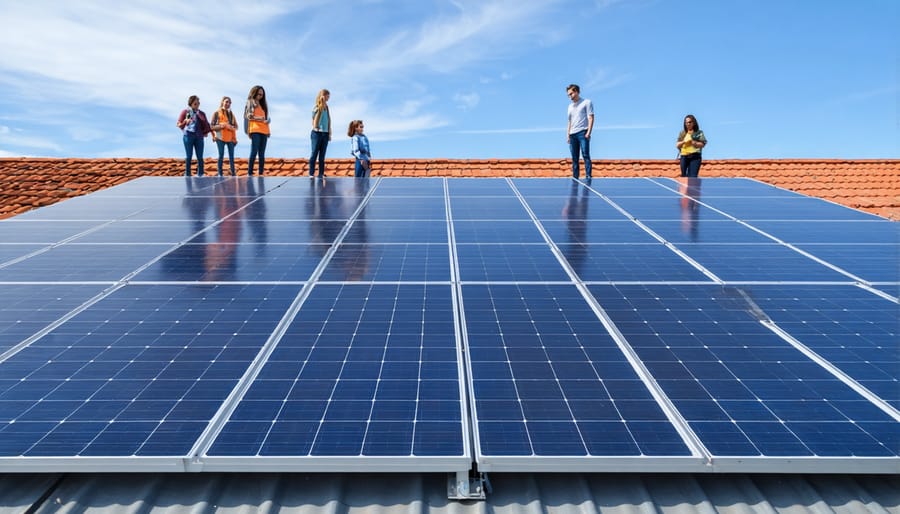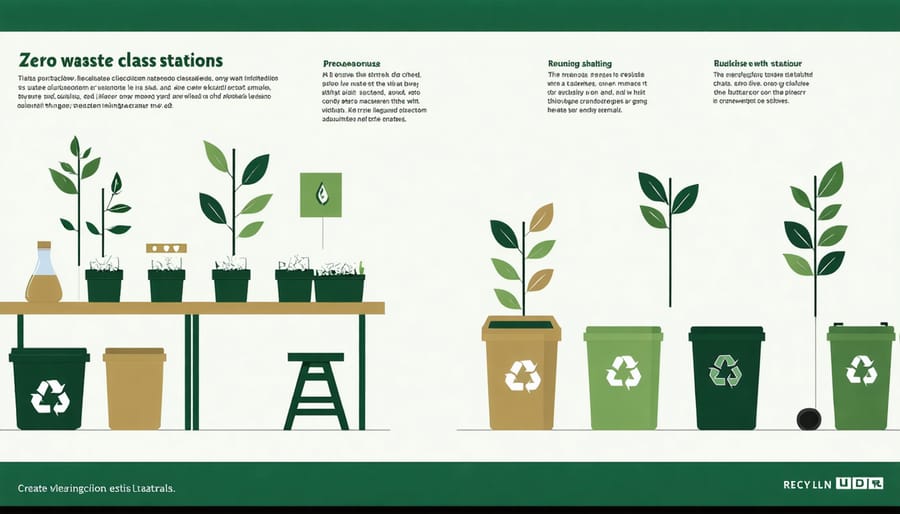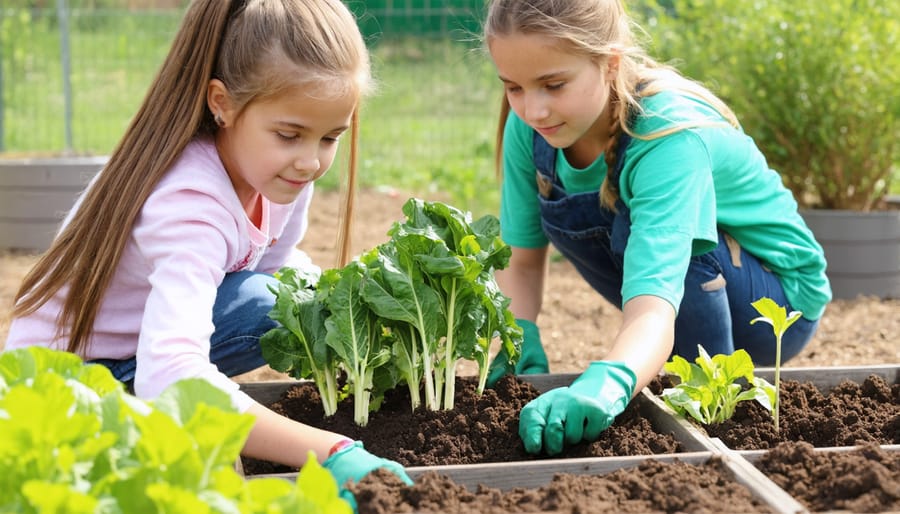
Transforming our schools into sustainable havens isn’t just an environmental necessity—it’s a powerful investment in our future. As educators and administrators embrace the journey of making schools eco-friendly, four fundamental principles emerge as the cornerstones of lasting change. These principles don’t just protect our planet; they create vibrant learning environments, reduce operational costs, and inspire the next generation of environmental stewards.
From the bustling corridors of urban academies to quiet rural classrooms, sustainability principles transcend size and budget constraints. They offer a practical roadmap for institutions ready to make meaningful change while delivering tangible benefits to both the environment and bottom line. By understanding and implementing these core principles, schools can create a ripple effect that extends far beyond their campus boundaries, influencing families, communities, and future decision-makers.
Let’s explore how these four principles of sustainability can transform your educational institution into a model of environmental responsibility and innovation.
Resource Conservation: The Foundation of Sustainable Education
Smart Energy Management
When it comes to making our schools more eco-friendly, smart energy management is a game-changer that can help transform schools through sustainable practices while reducing costs. I’ve seen firsthand how simple changes can make a big difference in our educational facilities. Start by installing motion-sensor lighting in classrooms and hallways – it’s amazing how much energy we save when lights automatically turn off in empty spaces!
Consider upgrading to LED bulbs throughout the building and implementing programmable thermostats that adjust temperatures during off-hours. One of my favorite approaches is creating an energy monitoring team comprising staff and students, making sustainability a community effort. They can track usage patterns and suggest improvements, turning energy management into an educational opportunity.
Don’t forget about natural lighting – maximizing daylight through strategic window placement and light-colored walls can significantly reduce artificial lighting needs. Additionally, regular maintenance of HVAC systems ensures they’re running efficiently, and encouraging simple habits like turning off computers at day’s end can lead to substantial energy savings.

Water Conservation Strategies
Water conservation is one of the most impactful ways we can contribute to sustainability in our daily lives. I remember when I first started my own water-saving journey – it began with simply turning off the tap while brushing my teeth! From there, I discovered numerous practical strategies that make a real difference without disrupting our routines.
Start by conducting a water audit to identify areas where you’re using the most water. Installing low-flow faucets and showerheads can reduce water usage by up to 50% while maintaining good pressure. Consider collecting rainwater for garden irrigation – I’ve found that even a simple barrel system can save gallons during growing season.
In the classroom or office, encourage students and colleagues to use reusable water bottles and report any leaking fixtures immediately. Implementing dual-flush toilets and sensor-operated faucets in restrooms can significantly decrease water consumption. For outdoor spaces, choose drought-resistant plants and water early morning or evening to minimize evaporation.
Remember, every drop counts! By making these changes, you’re not just saving water – you’re also reducing energy costs and preserving this precious resource for future generations.
Waste Reduction and Recycling Programs

Creating Zero-Waste Classrooms
Creating a zero-waste classroom might seem daunting at first, but I’ve found that small changes can lead to significant impact. Start by implementing a simple sorting system with clearly labeled bins for recyclables, compostables, and landfill items. Encourage students to use reusable water bottles and lunch containers, making it a fun challenge to see who can maintain a waste-free lunch streak.
Digital technologies can dramatically reduce paper waste – consider using tablets or laptops for assignments when possible. When paper is necessary, set up a scrap paper station for rough work and art projects. I’ve seen incredible creativity bloom when students transform “waste” materials into beautiful craft projects!
Keep a classroom supply swap box where students can share gently used items instead of buying new ones. Implement a “borrow first” policy for commonly needed supplies like scissors and rulers. For special events and celebrations, opt for reusable decorations that can be stored and used year after year.
Remember to involve students in the process – they often come up with the most innovative solutions and become enthusiastic advocates for sustainability in their homes too.
School-Wide Recycling Initiatives
Establishing an effective school-wide recycling program starts with making it accessible and engaging for everyone. I remember visiting a local elementary school that transformed their recycling initiative into a friendly competition between classrooms, and the results were incredible! The key is to place clearly labeled recycling bins in high-traffic areas – think cafeterias, hallways, and classrooms – and ensure they’re paired with regular trash bins to make proper disposal effortless.
Creating a “Green Team” of student and staff volunteers can help maintain momentum and educate the school community about proper recycling practices. Consider designating classroom recycling monitors who can ensure materials are sorted correctly and inspire their peers to participate. Working with your local recycling facility is essential – they often provide free educational resources and can help establish collection schedules that work for your school.
Don’t forget to track and celebrate your progress! Display monthly recycling statistics on bulletin boards or in newsletters, and consider implementing incentive programs for classes that consistently recycle correctly. This not only motivates continued participation but also helps students understand their direct impact on environmental conservation.
Sustainable Procurement Practices
Eco-Friendly Supply Selection
When it comes to creating a sustainable environment, thoughtful supply selection makes all the difference. I learned this firsthand when helping transform our local community center into an eco-friendly space. The key is to partner with suppliers who share your commitment to environmental stewardship and can provide transparent information about their sourcing practices.
Start by creating a checklist of environmental criteria for your supplies. Look for materials that are recycled, recyclable, or biodegradable. Consider products made from renewable resources like bamboo or sustainably harvested wood. Energy-efficient equipment and supplies with minimal packaging should also be priorities.
Don’t forget to evaluate your suppliers’ own sustainability practices. Do they use renewable energy? How do they handle waste? What about their transportation methods? Building relationships with local suppliers can reduce transportation emissions while supporting your community’s economy.
Remember, sustainable supply selection isn’t just about the products themselves – it’s about creating a complete cycle of responsibility. When possible, choose suppliers who take back and responsibly dispose of or recycle their products at the end of their life cycle.
Long-Term Cost Benefits
When I first started exploring sustainable purchasing for my school district, I was amazed to discover how initial costs often transform into significant savings over time. It’s like planting a money tree that grows steadily with each passing year! Let me share what I’ve learned about the financial benefits of sustainable choices.
Investing in energy-efficient equipment and sustainable materials might seem expensive at first, but the long-term savings are impressive. For example, LED lighting systems typically pay for themselves within two years through reduced energy costs and longer lifespans. Similarly, water-efficient fixtures can cut utility bills by up to 30% annually.
Sustainable purchasing also helps avoid hidden costs. When you choose durable, high-quality materials, you spend less on replacements and maintenance. Plus, as environmental regulations become stricter, institutions with sustainable practices already in place avoid costly compliance updates.
Consider this: many suppliers now offer better pricing for bulk sustainable products, and some governments provide tax incentives for green initiatives. By making sustainable choices today, you’re not just saving money – you’re future-proofing your institution against rising resource costs and regulatory changes.
Community Engagement and Education
Student-Led Green Initiatives
When it comes to creating lasting environmental change, students often prove to be the most passionate and innovative champions. By empowering them to take the lead in sustainability initiatives, we not only ignite student engagement but also foster a sense of environmental responsibility that extends far beyond the classroom.
Consider starting an eco-council where students can propose and manage their own green projects. From organizing recycling programs to maintaining school gardens, these hands-on experiences help students develop leadership skills while making tangible environmental impacts. I’ve seen firsthand how a simple composting initiative led by middle school students transformed into a community-wide movement, inspiring local restaurants to donate food scraps for the school’s garden.
Encourage students to conduct energy audits, organize zero-waste challenges, or create awareness campaigns through social media. These projects not only reduce your institution’s environmental footprint but also help students understand the real-world applications of sustainability principles. The best part? When students take ownership of these initiatives, they’re more likely to maintain long-term commitment and inspire their peers to join the cause.

Parent and Staff Involvement
Building a sustainable future requires the active participation of everyone in our educational community. I’ve seen firsthand how involving parents and staff creates a powerful ripple effect that extends far beyond school walls. Start by forming a sustainability committee that brings together teachers, parents, and administrative staff to share ideas and coordinate efforts.
Consider organizing monthly workshops where parents and staff can learn about eco-friendly practices they can implement both at school and home. These sessions create wonderful opportunities for knowledge sharing – I remember how one parent’s composting demonstration inspired an entire grade level to start their own garden project!
Encourage staff members to become sustainability champions in their departments. From the cafeteria team implementing food waste reduction strategies to maintenance staff suggesting energy-saving solutions, everyone has valuable insights to contribute. Create a digital newsletter or communication channel where success stories and tips can be shared regularly.
Remember to celebrate small wins and recognize those making a difference. When people feel their efforts are valued, they’re more likely to maintain their commitment to sustainability long-term.
As we’ve explored together, implementing the four principles of sustainability isn’t just about protecting our environment – it’s about creating a better future for ourselves and generations to come. By embracing these principles in our daily lives and institutions, we can make meaningful changes that ripple through our communities and beyond.
I’ve seen firsthand how small changes can lead to significant impact. From schools that have reduced their energy costs by 40% through sustainable practices to communities that have transformed their waste management systems, the benefits are both immediate and long-lasting. Not only do these changes help our planet, but they also create healthier spaces for learning and living while offering substantial cost savings.
Remember, sustainability isn’t about perfection – it’s about progress. Start with one principle that resonates most with you or your institution, and build from there. Whether it’s implementing a recycling program, switching to energy-efficient lighting, or creating a sustainable purchasing policy, every step counts.
Together, we can create a more sustainable future while inspiring others to join this important journey. Let’s take that first step today!



